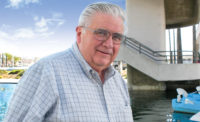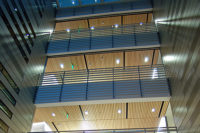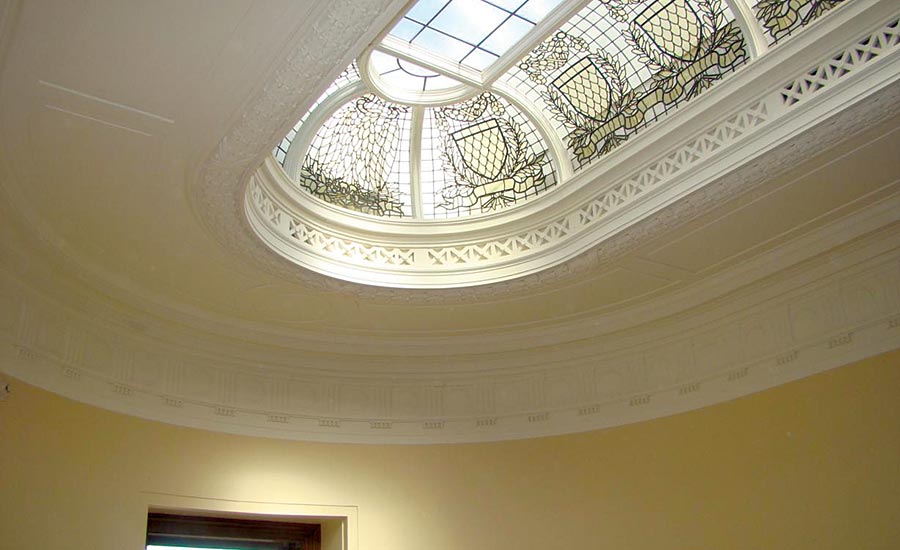Capitol Improvements: Interior Plastering in Minnesota





Mending indiscriminately broken walls by means that best accommodate the situation: Here blue board infill cavities created by “channeling.”

Minor hallway with major improvements. Complex ceiling was framed by Mulcahy Nickolaus crew, then finished in drywall.

Barrel vault ceiling framed and finished in veneer plaster. Note the complex “pie shaped” groin fitted at the end of the room.



M/N work extends above the House Chambers to the visitor’s balcony/gallery.












Located close to its eastern border and the confluence of the Mississippi and Saint Croix rivers, St. Paul was a central trade center for the Minnesota and Wisconsin Territories in 1841. That fact eventually institutionalized Saint Paul as the hub of government, thus a simple first capitol building was built in 1854. As Minnesota gained statehood in 1858, some conniving politicians plotted to relocate the capitol to the more farm-centric town of Saint Peter. A building was even started, but the plot was stifled by a distressed lawmaker who hid the original capitol “move bill” from being voted upon. Legal maneuvering eventually quashed those efforts entirely and as the government expanded, so did the old capitol building.
On a late winter night in 1881, the House and Senate were finalizing bills for the legislative session when a fire broke out. Along with the elected officials, there were visitors in the chamber galleries. A total of 300 people made it out with their lives through windows and the only operable exit from the building. Although no one died, the library and other valuable documents were lost. The brick and wood framed building succumbed in total ruin.
The cause of the fire was never fully explained; however local lore had it that because a bill had been introduced to build a new capitol, the fire was set by a lit cigar as impetus to fund a new structure. In fact a second capitol was built on the same site, but by 1893 it was deemed poorly ventilated and too small for a growing populace.¹
Third One is the Charm
Enter local Architect Cass Gilbert. Gilbert was actually born in Ohio, but raised in Saint Paul, dropping out of Macalester College before joining a local architectural firm and eventually completing a degree at MIT. His design of Minnesota’s “Star of the North” effectively ignited his career which cemented his reputation in grand edifices all over the country. Building of the new state capitol began in 1896 and was completed in 1905. But over the next century the capitol continued to be remodeled in patchwork fashion to meet the demanding needs of its constituents.
Since 2013, the Minnesota State Capitol has been undergoing a $310 million update that included new HVAC, plumbing, electrical infrastructure, a new roof and stone replacements on the exterior. Modern convenience also necessitated bringing the structure into the digital age.
“There’s hardly a pipe or anything else in this building that’s not going to be new,” says Rik Myhre, senior project manager with JE Dunn,² the general contracting company leading the restoration efforts. This statement is not lost on Mulcahy Nickolaus LLC, the wall and ceiling contractor charged with fixing the chaos wrought upon the majority of the plaster by the mechanical trades.
“There wasn’t a wall within the building that was not affected by a jack hammer,” says Project Foreman Dale Pramann. Walls were first marked with various paint colors of lines and arrows to direct the partial removal of a finished wall to uncover a chase for the subsequent plumbing, ductwork, electrical, or other trade. “Channeling” was the phrase that kept popping up by the Mulcahy Nickolaus (M/N) staff, referring to the breaches in the 100 year-old artisan plaster flatwork walls and ceilings left for repair. Channeling was probably an accurate term in the paranormal sense of the word as well, as the process uncovered a multitude of ghosts that remained hidden until they were uncovered in the demolition process. “Every wall hid surprises,” notes Rob Hannibal, M/N senior project estimator, “we came across brick, clay tile, metal lath, Pyrobar, truss studs—you name it.”
This caused me to ask the obvious: “How in the world were you able to establish a bid number with so many surprises?”
Kiddingly, Rob expressed that the bid took five weeks of his life away. Indeed, it should be noted that the course of the work did create some anxiety and sleepless nights on the part of the M/N team. “Hammel Green Abrahamson Architects actually did a great job in defining and clueing us in on the contract by zones and pictures,” acknowledges Rob. “We spent a good two weeks comparing elevation and detail drawings with actual site conditions to arrive at reasonable estimates,” he adds.
The circumstances of the demolition often dictated its renovation. “In some places we went with plaster” says Rob. “In other areas, drywall was used or we in-filled with ‘blue board’ (veneer plaster base) and mended everything together with veneer plaster.” Still, other areas demanded the attention of a qualified lather with expertise in channel iron and cross furring.
As the author of this article, M/N took me on an early tour of the building in October of last year. At the time of this writing (February 2017), the building has again been taken over for use by the legislature, however work continues until a grand re-opening in August.
At first glance, the thing I was struck by in this massive undertaking, was the dance floor constructed of scaffolding under the huge rotunda dome, inspired by St. Peter’s Basilica in Rome.
“We did some patching and repairing in some of these more elaborate areas,” says M/N partner Brian Mulcahy, “but the majority of the artistic finer details, painting and gilding were done by Conrad Schmitt Studios (New Berlin, Wis.).”
Brian was perhaps being a bit modest. As our tour continued they took me into the Senate and House Chambers (pictures page 31) where M/N had done wide ranging work that also extended into the gallery balconies.
As I followed the M/N contingent we arrived at what has been described in planning as “minor” hallways that actually had some very “major” renovations. Dale Pramann notes how they had to fabricate framing to support an arched drywall ceiling that concealed many new mechanical and electronic features. It was here that I remarked that the use of modern drywall actually exceeded the quality of the old historical plaster work.
Similarly, in a room adjacent to the Governor’s office we looked up to find a barrel shaped ceiling with a rather complex pie wedge (groin) geometry at the end wall. “All of this is constructed in veneer plaster on ‘blue board’ attached to hat channel” remarked Tony Nickolaus, the other half of the M/N partnership. To which I responded “but how did you figure out how to miter the blue board where it intersects?” Tony’s wry response was “That’s why it’s good to have a Dale Pramann on the team.”
After moving about to several floors of the massive building I became a little disoriented as to where I was. This perhaps underscores the complexity of the undertaking. M/N led me into a legislative hearing room (above) replete with a beautiful oval shaped oak banister, large TV monitors with state of the art sound and digital streaming capability. All of this had to be negotiated around new drywall and ornamental plaster elements.
The next stop in the tour took us to the top of an oblong staircase which serpentines unsupported in the center and descends multiple floors. Capped at the ceiling by a beautiful skylight, M/N used an old plastering technique called “canvassing” with a modern twist to resurface the walls and smooth the transition to the curved ceiling. Canvassing in old school parlance means to essentially wallpaper with strips of canvas embedded in plaster. The modern twist in this configuration was fiberglass mesh specifically designed for this type of application.
Descending the stairs we ended up in the basement of the capitol where again M/N’s expertise was required in the Governor’s Dining Room. What was interesting here was the fact that the floor was actually lowered to provide for more headroom.
Our final stop took us to an area directly under the rotunda. Known as the G15, during construction, the room, used as an event space is exceptionally modern in comparison to the historical permanence of the rest of the structure. It is highlighted by a large coffered ceiling inspired around a “Star of the North” medallion at its center. While M/N was not the original fabricator of the ceiling, it was their expertise that was needed in making structural repairs and refurbishing the drywall elements of the feature.
Press releases on the renovation really only play lip service to how well the renovation of the capitol turned out. The real story is in the knowledge and expertise of the craftsmen that put the whole thing back together. “As unexpected as a lot of the issues presented themselves, we’re proud of how our guys performed and how the project turned out,” expressed Tony Nickolaus. Asked if they would do it again, Rob Hannibal was a bit reluctant in his response: “The die has apparently been cast,” he notes. “We are also finishing up work on another plaster renovation; Scoville Hall on the National Register of Historic Buildings on the Campus of Carleton College in Northfield, Minnesota.”
Looking for a reprint of this article?
From high-res PDFs to custom plaques, order your copy today!


















